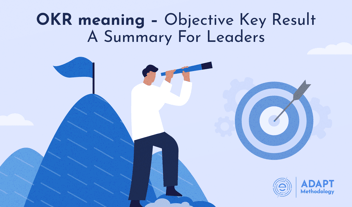OKR vs. KPI: What's the REAL Difference and Why It Matters

In the world of business, performance measurement and goal-setting are crucial components of a successful strategy. Two popular frameworks that help organizations define, track, and achieve their goals are Objectives and Key Results (OKRs) and Key Performance Indicators (KPIs).
While both have their advantages, understanding the real difference between OKRs and KPIs and why it matters can help your organization thrive. In this article, we will explore the definitions, importance, and key differences between OKRs and KPIs, and discuss why understanding these differences matters for your business.
Understanding Objectives and Key Results (OKRs)
Definition
Objectives and Key Results (OKRs) is a goal-setting framework initially developed by Intel and popularized by Google. It involves defining objectives, which are qualitative and aspirational goals, and key results, which are quantitative and measurable outcomes that indicate progress toward the objective.
Importance
OKRs help organizations align their teams and resources around a shared vision, driving growth and innovation. They promote transparency, accountability, and collaboration within an organization, as everyone works towards achieving common objectives.
Examples
An example of an OKR for a software development team might be:
Objective: Improve the user experience of our mobile app. Key Results:
- Reduce app crashes by 50%.
- Increase user ratings to 4.5 stars on the app store.
- Decrease the average loading time of the app by 20%.
Understanding Key Performance Indicators (KPIs)
Definition
Key Performance Indicators (KPIs) are measurable values that demonstrate how effectively an organization, department, or individual is achieving their goals. KPIs act as a performance tracking tool, monitoring progress towards strategic objectives.
Importance
KPIs allow organizations to evaluate their performance in various areas, identify strengths and weaknesses, and make data-driven decisions. By regularly tracking KPIs, organizations can ensure they are on the right path to achieving their goals and quickly make adjustments when needed.
Examples
Examples of KPIs for a sales team might include:
- A number of new customers acquired.
- Sales revenue.
- Average deal size.
 Key Differences between OKRs and KPIs
Key Differences between OKRs and KPIs
Goals and Metrics
While both OKRs and KPIs involve setting goals, OKRs focus on ambitious, aspirational objectives, while KPIs track performance towards more specific, predefined targets. Key results in OKRs are outcome-based, whereas KPIs are often output-based.
Timeframe
OKRs usually follow a shorter timeframe (quarterly or monthly), promoting agility and adaptability. KPIs, on the other hand, can be tracked daily, weekly, or monthly, depending on the nature of the performance indicator.
Flexibility
OKRs are designed to be flexible and adjustable, allowing organizations to adapt their objectives as circumstances change. KPIs are more rigid and usually remain consistent over time, providing a stable benchmark for performance measurement.
Alignment
OKRs promote alignment and collaboration across teams, as they often focus on cross-functional objectives. KPIs, conversely, are typically focused on individual departments or roles, and may not encourage the same level of cross-team collaboration.
Focus
OKRs encourage a focus on outcomes and the big picture, inspiring teams to think creatively and push boundaries. KPIs tend to emphasize outputs and specific targets, which can sometimes lead to a more narrow focus on meeting those targets rather than fostering innovation.
Why Understanding the Difference Matters
Strategy and Performance
Understanding the difference between OKRs and KPIs can help organizations create a more effective strategy for achieving their goals. By using the right framework, businesses can better track their progress, make data-driven decisions, and adapt their approach as needed to optimize performance.
Company Culture
The choice between OKRs and KPIs can influence an organization's culture. OKRs tend to foster a more collaborative, innovative, and transparent environment, while KPIs can create a more results-driven, competitive atmosphere. Understanding these differences can help organizations choose the framework that aligns with their desired company culture.
Employee Engagement
Employees are more likely to be engaged and motivated when they understand how their work contributes to the overall objectives of the organization. By choosing the right framework for goal-setting and performance measurement, organizations can ensure that their employees are aligned and invested in the company's success.
Decision Making
Understanding the difference between OKRs and KPIs can help organizations make better decisions about resource allocation, prioritization, and strategic planning. By using the right framework, businesses can more accurately measure their progress and make informed decisions based on data.
Choosing the Right Framework for Your Business
When deciding between OKRs and KPIs, it's essential to consider your organization's specific needs, goals, and culture. If your organization values innovation, collaboration, and flexibility, OKRs may be the better choice. If you need a more consistent, output-focused performance measurement system, KPIs might be more suitable. Many organizations also choose to use a combination of both frameworks to create a more comprehensive performance management system.
FAQs
-
What are OKRs? Objectives and Key Results (OKRs) is a goal-setting framework that involves defining qualitative objectives and quantitative key results to measure progress toward those objectives.
-
What are KPIs? Key Performance Indicators (KPIs) are measurable values that demonstrate how effectively an organization, department, or individual is achieving their goals.
-
How do OKRs differ from KPIs? OKRs focus on ambitious, aspirational objectives and outcomes, while KPIs track performance towards specific, predefined targets. OKRs also promote alignment and collaboration across teams, whereas KPIs are often focused on individual departments or roles.
-
Why is understanding the difference between OKRs and KPIs important? Understanding the difference between OKRs and KPIs helps organizations create a more effective strategy for achieving their goals, fosters a better company culture, enhances employee engagement, and supports data-driven decision-making.
-
Can an organization use both OKRs and KPIs? Yes, many organizations choose to use a combination of both frameworks to create a more comprehensive performance management system. By utilizing the strengths of both OKRs and KPIs, organizations can effectively track progress, align teams, and measure performance across various aspects of their business.
Conclusion
Understanding the real difference between OKRs and KPIs is crucial for organizations looking to optimize their performance and achieve their goals. By carefully considering the unique aspects of each framework and how they align with your organization's needs and culture, you can make the right choice for your business and set yourself up for success.
Did you like this article?
If you liked this article and you are looking for a way to align everyone in your organization, let’s have a call or simply download our OKR Guide. We also offer OKR consulting and OKR training, but our approach differs from other companies, we believe OKRs should be fully integrated with your product development.






